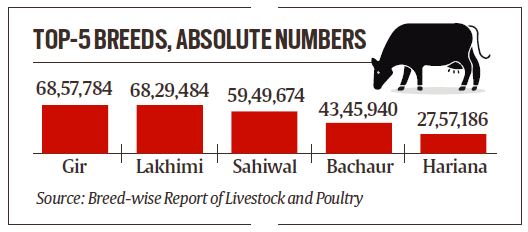TWENTY-THREE BREEDS of indigenous cattle registered a decline in numbers – ranging from 1.08% to 93.48% – in seven years between 2012 and 2019, according to the latest breed-wise report of livestock and poultry in India.
The report, which is based on 20th Livestock Census conducted during 2018-19, was released by Union Fisheries, Animal Husbandry and Dairying Minister Parshottam Rupala on Thursday.

According to the report, the total number of indigenous cattle declined by 6% to 14.21 crore in 2019 from 15.12 crore in 2012. Their share in the total cattle population fell to 73% from 79% during this period.

However, the number of Exotic/Crossbred cattle grew from 3.9 crore in 2012 to 5 crore in 2019. The Census defines “Exotic” cattle as “the animals which have their origin in other countries”.
According to the 20th Livestock Census, “Animals which belong to Descript (identified)/Non-descript (non-identified) breeds of indigenous origin are considered as indigenous animals.”
The report has divided indigenous cattle population in two groups – 41 recognised breeds and Non-Descript. Of the indigenous cattle population, Non-Descript had the most numbers – 10.02 crore – during 2019, while the combined number of 41 breeds stood at 2.49 crore. However, the comparable data is available for only 37 breeds, of which 23 breeds have seen a decline, while 14 have registered an increase in numbers.
Among five breeds, which have seen maximum decline in their numbers, are Khariar (-93%), Kherigarh (-75%), Kenkatha (-67%), Motu (56%) and Hariana (56%). The number of Khariar, found mainly in Odisha and Chhattisgarh, has come down from 3,83,824 in 2013 to 25,021 in 2019.
Story continues below this ad
The Hariana breed is found mainly in Haryana, Uttar Pradesh, Rajasthan, Madhya Pradesh and Bihar; Motu is found in Odisha; Red Kandhari in Maharashtra; Kenkatha in Madhya Pradesh and Uttar Pradesh; and Kherigarh in Uttar Pradesh.
Other breeds which have registered a decline are: Dangi, found mainly in Maharashtra and Gujarat; Rathi (Rajasthan, Punjab and Haryana); Deoni (Maharashtra, Karnataka and Telangana); Tharparkar (Uttar Pradesh, Rajasthan and Jharkhand); Kangayam (Tamil Nadu); Binjharpuri (Odisha); Kankrej (Gujarat and Rajasthan); Nagori (Rajasthan and Punjab); Malnad Gidda (Karnataka); Mewati (Uttar Pradesh); Khillar (Karnataka and Maharashtra); Kosali (Chhattisgarh); Malvi (Madhya Pradesh, Maharashtra and Rajasthan); Umbla Cherry (Tamil Nadu); Gaolao (Madhya Pradesh and Maharashtra); Ghumusari (Odisha); and Hallikar (Karnataka).
The 14 indigenous breeds, which have registered an increase between 2012-19 are: Vechur (512%), Punganur, (369%), Bargur (240%), Bachaur (181%), Krishna Valley (57%), Pulikulum, (38%), Siri (36%), Gir (34.12%), Amritmahal (31%), Sahiwal (22%), Ongole (11%), Red Sindhi (10%), Nimari (6) and Ponwar (2.46%).
In terms of absolute number, Gir had the highest population of 68.57 lakh followed by Lakhimi (68.29 lakh) and Sahiwal (59 lakh).
Story continues below this ad
According to the 20th Livestock Census, 36.04% of the livestock population belong to cattle.
Newsletter | Click to get the day’s best explainers in your inbox
On the occasion, Rupala highlighted the “significance” of the report for the upgradation of livestock.
The data comes days after the Supreme Court issued notices to Centre and states on a plea seeking its intervention in the decline in the population of indigenous cows.










